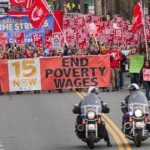
Warning: Illegal string offset 'output_key' in /nfs/aesop1/hw00/d92/povblog/wordpress/wp-includes/nav-menu.php on line 604
Warning: Illegal string offset 'output_key' in /nfs/aesop1/hw00/d92/povblog/wordpress/wp-includes/nav-menu.php on line 604
Warning: Illegal string offset 'output_key' in /nfs/aesop1/hw00/d92/povblog/wordpress/wp-includes/nav-menu.php on line 604

The New One-Night House: Losing and Gaining Propertied Citizenship After the Foreclosure Crisis
Maggie Wilson, University of Washington, Department of Geography
“There is a belief around the world that if you can build a house between sunset and sunrise, then the owner of the land cannot expel you. There are many variations on this theme. The condition might be that the roof is in place, or that a pot is boiling on the fire, or that smoke can be seen emerging from the chimney. …The intriguingly widespread folklore of the one-night house seems to be an attempt to find a loophole in the stranglehold of land-ownership to create an opportunity to change a family’s destiny.”
–Colin Ward, Cotters and Squatters: Housing’s Hidden History (2002)
There is something alluringly American about the idea of the one-night house that anarchist writer Colin Ward describes in his history of British traditions of squatting. What, after all, could be more American than quickly translating an industrious work ethic into a single-family home, and all the social and financial security that it represents? But acquiring property in this way is also deeply subversive, as it offers an alternative to the transactional relationships that are central to capitalist practices of property ownership. It is not a purchase but a taking, an invasion rather than a negotiation.
For decades, home ownership has been many American families’ primary store of wealth. A house, so the conventional wisdom went, was more than shelter, but an investment that would inevitably increase in value over time. In fact, the online mortgage calculator provided by Freddie Mac itself (himself?) would only accept positive values for home appreciation rates—it assumed that it was only possible for home prices to increase. This was a tool designed to help potential homebuyers determine whether or not buying a home was a sound financial decision. The prevailing assumption about home prices in America was quite literally encoded into the logic of the institutions, both public and private, at the core of the home financing system and the lending practices that they promoted and enacted.
In retrospect, of course, this thinking was toxically misguided. The very same logic about the American housing market that encouraged individuals to buy rather than rent was a strong incentive to mortgage lenders as well. Since residential property was assumed to be such a fundamentally sound investment, even if a borrower defaulted on a mortgage, the lender could theoretically resell the house to recoup its losses. And so it went, until the system was pushed past its breaking point.
We are all by now familiar with the wide-ranging and destructive effects of the collapse of the American housing market and subsequent financial crisis it unleashed. The epidemic of foreclosures that was one of its most proximate effects has contributed enormously to the further entrenchment of poverty and inequality in the United States all on its own. One of the most disheartening trends that it has contributed to is the widening of the wealth gap in America, and particularly the wealth gap among races. While the difference in average income for different racial groups remained more or less constant throughout the recession, the difference in average family wealth increased dramatically as nonwhite families lost their primary financial assets—their homes—in disproportionate numbers. As of 2010, the average white family was about six times as wealthy as the average nonwhite family. Many anti-poverty initiatives, like campaigns to raise the minimum wage, focus primarily on income, but in some ways, the wealth gap has a greater influence on the perpetuation and reinforcement of inequality.
But most houses are also homes, and a foreclosure is more than a financial loss for most families. Foreclosure features prominently in the narrative of “middle-class slippage” that Elwood and Lawson (2013) argue was foregrounded in the reframing of poverty during the recession. This narrative casts former members of the middle class as the central victims of the recession, and links the emergence of this new category of the poor to suburban places, while the urban and rural poor are largely ignored. The multiple meanings attached to owning a house in the suburbs—as an emblem of prosperity, a signifier of membership in the middle class, and a source of financial stability—were disrupted during the foreclosure crisis, and the images of half-finished suburban construction projects and abandoned, overgrown McMansions suggested an implosion of a key part of the American middle class itself.
Losing a home, becoming propertyless, amounts to a form of social displacement, a revocation of citizenship within the paradigm that Roy (2003) lays out. The paradigm of propertied citizenship interprets the rights relationship between subject and sovereign through property ownership. This was, of course, literally the case during the first few decades of American history; voting rights were contingent upon property ownership, and so the propertyless were by definition disenfranchised. While voting rights laws have evolved considerably since then, propertylessness, within the paradigm of propertied citizenship, is a form of civic exclusion and deviance. Roy uses the urban American homeless as a paradigmatic example of a group that is excluded from the rights of the propertied citizen, but the suburban families who have been displaced from their homes via foreclosure are also non-citizens within this paradigm.
Roy offers an alternative to homelessness for the propertyless, however. If homelessness is the paradigmatic counterexample to propertied citizenship in the First World, she casts informal housing or squatting as its equivalent in the Third World. And she draws attention to the fact that squatting is not solely limited to the developing world by profiling an American anarchist group that practices squatting as a form of resistance to the paradigm of propertied citizenship. Homes Not Jails employs squatting as both a symbolic challenge to policies that persecute the homeless and as a tactic to take advantage of the doctrine of adverse possession, which represents a path to legal ownership through a form of “sweat equity,” a concept more familiar to the Third World than to the First. If an abandoned property is occupied, rehabilitated, and remade into a livable space, adverse possession provides a way for the rejuvenated property’s occupiers to acquire legal ownership. This type of squatting is a kind of reincarnation of the one-night house in a slightly different form and without the extreme temporal constraints, but still a path to property ownership directly through occupation and labor rather than through an exchange of money.
“Taking” houses in this way has seen a resurgence in some of the places that were most severely ravaged by the foreclosure crisis. While it need not take place under literal cover of darkness, it operates on the border between deviance and legitimacy, and opens up an alternative way of accessing the privileges that are tied up with property ownership. The rules that had governed entry and membership to the propertied middle-class for decades were upended in the foreclosure crisis. In its aftermath, these alternative methods of property acquisition seem particularly apt.
References:
Elwood S, Lawson V, 2013, “Whose crisis? Spatial imaginaries of class, poverty and vulnerability”Environment and Planning A 45(1), 103-108.
Roy A, 2003, “Paradigms of propertied citizenship: Transnational techniques of analysis” Urban Affairs Review 38(4), 273-89.
Ward C, 2002, Cotters and Squatter: Housing’s Hidden History. Nottingham: Five Leaves Publishing.






Leave a Reply